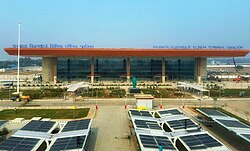Gwalior Airport
 From Wikipedia - Reading time: 11 min
From Wikipedia - Reading time: 11 min
Rajmata Vijayaraje Scindia Airport | |||||||||||||||
|---|---|---|---|---|---|---|---|---|---|---|---|---|---|---|---|
 | |||||||||||||||
| Summary | |||||||||||||||
| Airport type | Military & Public | ||||||||||||||
| Owner | Indian Air Force | ||||||||||||||
| Operator | Indian Air Force & Airports Authority of India | ||||||||||||||
| Serves | Gwalior | ||||||||||||||
| Location | Maharajpur, Gwalior, Madhya Pradesh, India | ||||||||||||||
| Opened | 1940[1] | ||||||||||||||
| Time zone | Indian Standard Time (+5:30) | ||||||||||||||
| Elevation AMSL | 617 ft / 188 m | ||||||||||||||
| Coordinates | 26°17′36″N 078°13′40″E / 26.29333°N 78.22778°E | ||||||||||||||
| Website | Gwalior Airport | ||||||||||||||
| Map | |||||||||||||||
| Runways | |||||||||||||||
| |||||||||||||||
| Statistics (April 2023 – March 2024) | |||||||||||||||
| |||||||||||||||
Rajmata Vijayaraje Scindia Terminal (IATA: GWL, ICAO: VIGR), also known as Gwalior Airport, is a domestic airport and an Indian Air Force base serving the city of Gwalior, Madhya Pradesh, India. It is located in Maharajpur, 10 km (6 mi) north-east of the Gwalior. It is one of the five airports in Madhya Pradesh. The airport is named after Vijaya Raje Scindia, former prominent Member of Parliament and Maharani Of Gwalior belonging to the Scindia dynasty of the Maratha Empire. It is the largest airport of Madhya Pradesh in terms of size and only airport in Central India which has two runways.
The airport is spread over 760.7 acres (307.8 hectares). The terminal building is spread over 20,000 m2 (220,000 sq ft), completed in 16 months and can handle 1,400 peak hour passengers, which is 3 times more than the old terminal building, and ancillary buildings, car parking, city-side development and other associated works at the airport. The construction of the new apron and the taxiways including associated works for parking of 13 narrowbody or small aircraft at the airport and there are some modern technologies, such as rainwater harvesting and solar energy will be used in the development of the new terminal building, by the commissioning of a new 2.5 GW solar power plant. The Airports Authority of India (AAI) has taken up the work for expansion of the airport. The airport is the only air force base in India with two operational parallel runways.
History
[edit]During the outbreak of World War I in 1942, the Royal Air Force (RAF) built this airport as a training base for pilots, and it also played an important role in the war effort, contributing to the Allied victory. When the war ended in 1947, it was transferred to the Indian Air Force (IAF), which also coincided with India’s independence. Indian Air Force IAS continues to operate a base at the airport, contributing to national security. Civil Aviation was opened in 1958, marking the beginning of new commercial connectivity for Gwalior airport. The airport’s first commercial flight was an Indian Airlines Douglas DC3 from Delhi [5]
The second runway was built in February 2009 and became operational in October 2010. airport’s infrastructure and facilities were upgraded during the 2000s. Recent changes include the construction of a new and larger terminal building at Gwalior airport, as well as the addition of some modern amenities is completed.
Airlines and destinations
[edit]| Airlines | Destinations |
|---|---|
| Air India Express | Bangalore,[6] Delhi |
| Akasa Air[7] | Ahmedabad, Mumbai[8] |
| Alliance Air[9] | Delhi, Indore |
| IndiGo | Delhi,[10] Mumbai[11] |
Statistics
[edit]Graphs are unavailable due to technical issues. There is more info on Phabricator and on MediaWiki.org. |
Accidents and incidents
[edit]- On May 6, 2021, a Beechcraft 250 belonging to the state of Madhya Pradesh crashed while landing at the airport. The three crew were hospitalized with minor injuries. The aircraft was carrying Remdesivir injections, which were undamaged.[12]
References
[edit]- ^ "Source".
- ^ "Annexure III – Passenger Data" (PDF). aai.aero. Retrieved 21 April 2024.
- ^ "Annexure II – Aircraft Movement Data" (PDF). aai.aero. Retrieved 21 April 2024.
- ^ "Annexure IV – Freight Movement Data" (PDF). aai.aero. Retrieved 21 April 2024.
- ^ Gupta, Sanskrati (23 February 2024). "Gwalior Airport: History, location, facilities, hotels, real estate more". Housing News. Retrieved 10 March 2024.
- ^ "Air India Express to launch flights to Ayodhya from January 16". JetArena. Retrieved 19 December 2023.
- ^ "Akasa Air to start Ahmedabad - Gwalior Flights from February 2024". AviationAll. Retrieved 25 January 2024.
- ^ "Gwalior-Mumbai Direct Flight To Start From Feb 27". Free Press Journal. 25 February 2024. Retrieved 28 February 2024.
- ^ "Bhopal: Alliance Air to start flight from Jabalpur-Bhopal-Gwalior".
- ^ "IndiGo to Start Daily Flights Connecting Gwalior with Indore, Delhi from September 1".
- ^ David Casey (18 November 2022). "Routes In Brief: Rolling Daily Updates (W/C Nov. 14, 2022)". Routes.
- ^ Tomar, Shruti (7 May 2021). "Plane carrying Remdesivir injections crash lands in MP's Gwalior". The Hindustan Times. Retrieved 9 May 2021.
External links
[edit]![]() Media related to Rajmata Vijaya Raje Scindia Airport at Wikimedia Commons
Media related to Rajmata Vijaya Raje Scindia Airport at Wikimedia Commons
 KSF
KSF
